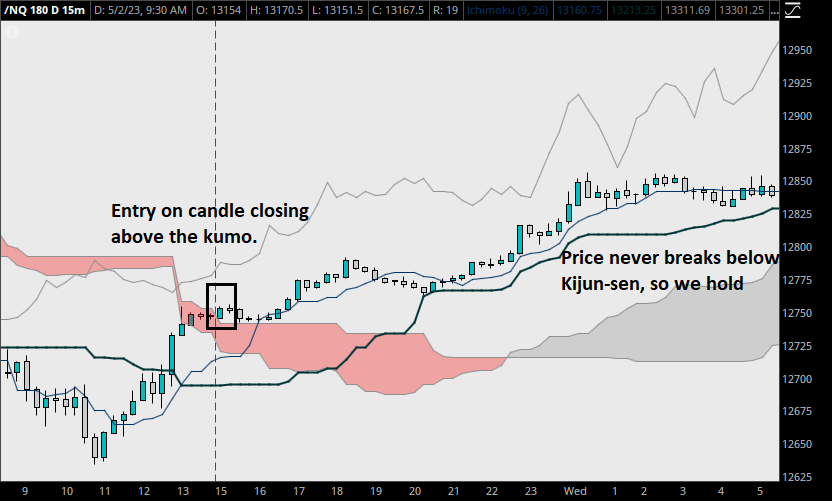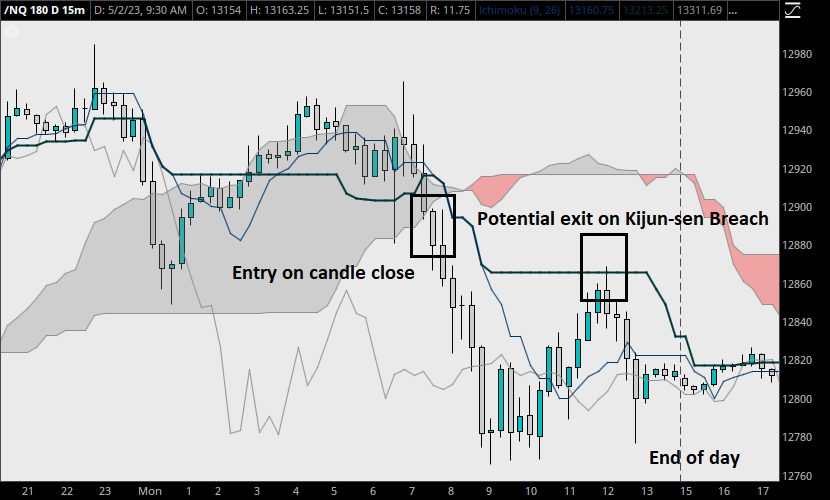In addition, any charts for financial instruments in this article are for education only. The examples shown here do not constitute trading advice or a solicitation to buy or sell any financial instrument. Past performance is not necessarily an indication of future performance.
If you would like to learn more, please read this Disclaimer for details.
The Ichimoku Cloud Breakout Strategy is one of the more common strategies that traders employ with this indicator. If you’re unfamiliar with the Ichimoku Cloud, be sure to read that post first. In addition, if you’re new to the concept of breakouts, I’ve made a complete guide to breakouts here.
This strategy primarily focuses on trend-following and aims to capture substantial price moves when a breakout from the cloud (kumo) occurs. I’ve provided some specific rules for entry, exit, and risk management, which are necessities in any good trading plan. If you’re here, you’re likely a more experienced trader, so let’s just jump into it.
Entry Rules
When identifying an Ichimoku cloud breakout for this strategy, it can be done a few different ways.
But before placing a trade, we need some strict rules for what makes an entry valid.
First, let’s identify the trend. We cannot base a strategy on an Ichimoku breakout without knowing the underlying trend. Ensure that the price is consistently above the Kumo for a bullish trend or below the Kumo for a bearish trend. If this is not easily apparent, consult the basics of the Ichimoku Cloud indicator in this thread.
Next, assuming we have a clear trend, we want to wait for a Kumo breakout. Enter a long position when the price closes above the Kumo in an uptrend or a short position when the price closes below the Kumo in a downtrend.
Now that we’re in, let’s confirm with the Chikou Span. We want to make sure the Chikou Span is above the price in a bullish trade or below the price in a bearish trade, confirming the direction.
Exit Rules
Naturally, we want our stop loss conditions to be set before we enter a trade. For a hard stop, consider a stop-loss below the Kijun-sen for a long position. Conversely, place it above the Kijun-sen for a short position.
If you’re using a trailing stop, use the Kijun-sen or the opposite edge of the Kumo as a reference for adjusting the stop-loss. You will have to adjust this as each candle closes.
Profit Targets
Ideally, our trade will close based on our profit target, and not our stop. What are the profits you’re looking for? Since I am not a fan of pure risk-reward ratios as profit targets, consider using the cloud itself.
There’s a few way to do this. We can use the Kumo projection, or the distance between the Tenkan-sen and Kijun-sen.
Kumo projection
The Ichimoku Cloud projects the Kumo 26 periods ahead, which can provide an idea of potential future support and resistance levels. In a long trade, you can set your profit target at the upper edge of the projected Kumo. Conversely, in a short trade, set your profit target at the lower edge of the projected Kumo.
Tenkan-sen and Kijun-sen gap
Another way to set a profit target is by measuring the distance between the Tenkan-sen (Conversion Line) and Kijun-sen (Base Line) at the time of entry. This distance can give you an idea of the recent price volatility and potential for price movement. Multiply this distance by a factor (e.g., 1.5 or 2) to set a profit target that is in line with the market’s recent volatility.
Trading the Ichimoku Cloud Breakout
Going Long
To keep things simple, we’re going to aim for a long based on the candle closing bullish above the Kumo. Once this happens, we will follow the trend and be ready to exit if any candle crosses below the Kijun-sen. Remember, first we identify that we are looking for a bullish trend

After we get a bullish close and get into our trade, note that the trend continues for quite some time. Day traders may not want to hold beyond the close on Wednesday, but this would make a spectacular swing trade if the trend continues longer than that.
Either way, since price does not cross back down below the Kijun-sen (the thicker black line), we can simply hold our long. This example shows how it can be much more profitable to have dynamic entry and exit conditions.
Going Short
Now let’s look at an example of a short position that our Ichimoku Cloud Breakout Strategy can help us with.
Here’s a chart of NQ. First, let’s determine if it meets our entry conditions.

The Kijun-sen is the thicker line so it’s easier to see.
Since we’re looking for price to close above or below the kumo, we decide to look for a short, since price is on its way down.
When the candle in the box closes, we can enter short. Then, we decide that our stop is going to be price closes above the Kijun-sen, which does not happen in this trade. Thus, we hold our short the entire morning.
Note that if you decide to exit on any breach of the Kijun-sen, you must exit at the 12:00 candle, where price briefly crosses above this line. Whichever method you use, make sure you stay consistent. The Ichimoku Cloud Strategy can work with either, but consistency is key.
Conclusion
Hopefully these examples show you how to tailor your strategy a bit more toward precision, and away from luck. It’s a more proactive approach, but it definitely pays off in some cases.
The power of the Ichimoku Cloud Breakout Strategy lies in its effectiveness in capitalizing on trending markets, so you will face difficulty when the markets are slower or range-bound.
Be sure to practice in different market conditions and time frames to find your sweet spot.
Leave a Reply